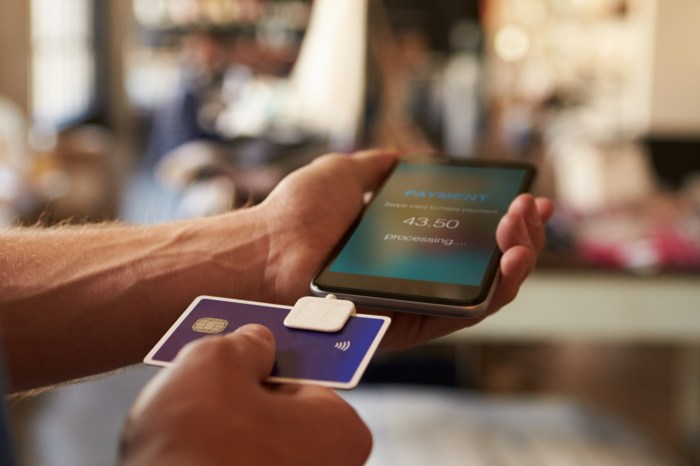Smartphone card readers have revolutionized the way we make payments, bringing convenience and security to mobile transactions. These compact devices, often smaller than a credit card, plug into your smartphone, transforming it into a portable point-of-sale terminal. From bustling marketplaces to quiet home offices, smartphone card readers have become an indispensable tool for businesses and individuals alike.
The evolution of smartphone card readers has been driven by advancements in mobile technology, particularly the development of Near Field Communication (NFC) and Bluetooth connectivity. These technologies enable seamless data transfer between the card reader, the smartphone, and the payment network, facilitating secure and swift transactions.
Introduction to Smartphone Card Readers
Smartphone card readers are small, portable devices that connect to smartphones or tablets, enabling them to accept credit and debit card payments. These readers transform a mobile device into a point-of-sale (POS) terminal, allowing businesses and individuals to process transactions conveniently and securely.
Smartphone card readers have revolutionized the way businesses and individuals handle payments, offering a seamless and accessible solution for various scenarios.
Functions and Applications, Smartphone card readers
Smartphone card readers offer a range of functions and applications, making them versatile tools for various situations. Here are some of the key features and use cases:
- Transaction Processing: The primary function of a smartphone card reader is to facilitate secure payment processing. Users can swipe, tap, or insert cards into the reader, which transmits the transaction information to the connected device for processing.
- Payment Acceptance: Smartphone card readers enable businesses and individuals to accept payments from various card types, including credit, debit, and prepaid cards.
- Mobile Point-of-Sale (mPOS): These readers enable businesses to operate a mobile POS system, allowing them to accept payments anywhere with a smartphone or tablet. This flexibility is particularly beneficial for businesses that operate on the go, such as food trucks, delivery services, and mobile retailers.
- Customer Convenience: Smartphone card readers offer customers a convenient and secure way to make payments, eliminating the need for cash or physical checks.
- Enhanced Security: Many smartphone card readers utilize advanced security features, such as encryption and tokenization, to protect sensitive payment data.
- Data Analytics: Some card readers provide data analytics capabilities, allowing businesses to track sales, customer behavior, and other valuable insights.
History and Evolution
The concept of using smartphones for payment processing emerged in the early 2000s, with the development of mobile payment technologies like near-field communication (NFC). The first smartphone card readers were bulky and primarily used for accepting payments through NFC-enabled devices.
The evolution of smartphone card readers has been driven by several factors, including:
- Technological Advancements: The development of smaller and more powerful processors, improved wireless connectivity, and advanced security protocols have enabled the creation of more compact and secure card readers.
- Increased Smartphone Penetration: The widespread adoption of smartphones has created a large market for mobile payment solutions.
- Growing Demand for Convenience: Consumers are increasingly demanding convenient and secure payment options, driving the adoption of smartphone card readers.
- Emerging Payment Technologies: The rise of contactless payments, mobile wallets, and other emerging technologies has further accelerated the adoption of smartphone card readers.
Types of Smartphone Card Readers
Smartphone card readers have become increasingly popular, offering a convenient and portable way to accept payments. These devices come in various forms, each with its own unique features and advantages. Understanding the different types of card readers available can help you choose the one that best suits your needs.
Card Readers by Connection Method
The connection method is a crucial factor in determining the functionality and usability of a smartphone card reader. Different types of connections offer distinct advantages and disadvantages.
- Bluetooth Card Readers: These readers connect wirelessly to your smartphone via Bluetooth, offering greater mobility and flexibility. They are generally easy to set up and use, allowing you to move around freely while accepting payments.
Bluetooth card readers are particularly useful for businesses that require mobility, such as food trucks, delivery services, and mobile retail operations.
- USB Card Readers: These readers connect directly to your smartphone’s USB port, providing a stable and reliable connection. They are often more affordable than Bluetooth card readers and may offer faster processing speeds.
USB card readers are suitable for businesses that need a more stationary setup, such as small shops, restaurants, or offices.
- NFC Card Readers: These readers utilize Near Field Communication (NFC) technology, allowing for contactless payments by tapping a credit or debit card against the reader. NFC card readers are fast, secure, and convenient, making them ideal for quick transactions.
NFC card readers are gaining popularity as contactless payments become more widespread. They are particularly useful for businesses with high transaction volume, such as coffee shops, convenience stores, and public transportation.
End of Discussion
Smartphone card readers have undeniably reshaped the landscape of mobile payments, offering a blend of convenience, security, and affordability. As technology continues to evolve, we can expect even more innovative features and applications to emerge, further solidifying the role of smartphone card readers in our increasingly digital world.
Smartphone card readers have become increasingly popular, offering convenience and portability for businesses and individuals alike. The development of these devices is closely tied to the advancements in smartphone app development , which enables the creation of secure and user-friendly payment processing applications.
These apps allow users to seamlessly accept payments, track transactions, and manage their finances, further enhancing the functionality of smartphone card readers.
 Informatif Berita Informatif Terbaru
Informatif Berita Informatif Terbaru
